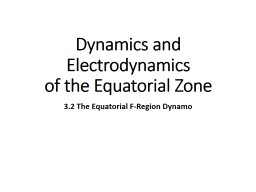

of the Equatorial Zone 32 The Equatorial FRegion Dynamo Emphasis in 31 1 must be mostly due to the electric field ExB drift 2 The drifts of plasma are up and to the west during the day and down and to the east ID: 1025711
Download Presentation The PPT/PDF document "3. Dynamics and Electrodynamics" is the property of its rightful owner. Permission is granted to download and print the materials on this web site for personal, non-commercial use only, and to display it on your personal computer provided you do not modify the materials and that you retain all copyright notices contained in the materials. By downloading content from our website, you accept the terms of this agreement.
1. 3. Dynamics and Electrodynamicsof the Equatorial Zone3.2 The Equatorial F-Region Dynamo
2. Emphasis in 3.1 1. must be mostly due to the electric field(ExB drift).2. The drifts of plasma are up and to the west during the day and down and to the east at night. 3. The peak eastward drift at night is twice as great as the peak westward drift during the day.4. The zonal drifts are much larger than the vertical velocities.5. The vertical drift is often strongly enhanced just after sunset but shows no comparable feature near sunrise. This is termed the prereversal enhancement of the vertical drift or, equivalently, of the eastward electric field component.6. There are strong solar cycle effects in the vertical drifts and moderate seasonal effects in both data sets.7. An equivalent statement is that the voltage difference between the dusk and dawn terminators
3. Thermospheric windsThermospheric winds provide the source of energy that maintains the electric field.Early observational data on thermospheric winds came from studies of the drag exerted on artificial satellites by the neutral atmosphere (King-Hele, 1970). Analysis of such data shows that the change in satellite inclination is directly related to the angular velocity of the atmosphere with respect to the rotating earthConclusion: the low-latitude thermosphere superrotates on average. (a net eastward average zonal flow of about 150 m/s near 350km altitude and about 50 m/s at 200km altitude, and it is most pronounced in the 2100–2400 local time period.)
4. Observed by satellitesIn the Pacific sectorAt Kwajalein, 08UT = 20LTAlthough the winds display a high degree of variability from day to day, to a first approximation the winds are eastward and quite strong (∼150 m/s) in the postsunset period, decaying in amplitude to less than 50 m/s after midnight.
5. Neutral winds at the postsunset periodSince there is no Coriolis force at the equator, in a steady state the winds should blow in the −∇p (due to the subsolar neutral atmospheric temperature bulge) direction from west to east across the sunset terminator.The speed of the wind is limited by the various drag terms. If the plasma is ignored, as the early modelers naturally did, viscosity is the only frictional factor.
6. in the lower atmosphere viscosity is provided by the interaction of eddies in the atmospheric flow—that is, by eddy viscosity. Above the turbopause, classical molecular viscosity becomes the dominant factor. (in Chapter 2)Viscosity coefficient where atomic oxygen has been assumed to be the dominant neutral (Dalgarno and Smith, 1962).The vertical temperature gradient is small in the upper thermosphere(e.g. F-region), and η is therefore virtually independent of height.
7. However, when comparing viscosity with the acceleration terms such as F = −(1/ρ)∇p, the kinematic viscosity (η/ρ) is what matters. Unlike η, this ratio increases exponentially with height as ρ decreases, which is responsible for the importance of viscosity in the thermosphere.→ Tenuous gas has a high viscosity.(counterintuitive)but what matters is the mean free path that carries velocity shear information from one height to another.where is the momentum flux density tensor due to waves in the medium (2.21b)
8. (2.21b) F: Pressure gradient acceleration (−) : kinematic viscosity f: Coriolis: ion drag frequency =+60m/s (over one H) equatorweak
9. Above 200 km, Viscosity exceeds all of the otherterms. = 0 as an upper boundary condition.
10. Thermospheric zonal winds equation at equatorial latitudeIn his early study of thermospheric winds, Lindzen (1966) took the observed diurnal component of the pressure gradient given experimentally by Harris and Priester (1965) and solved the simplest form of the resulting zonal wind equation at equatorial latitudes: (3.5)where u is the zonal component of the wind.Equation (3.5) is the function of p and ρ with x and zEven with a low estimate of the pressure term, however, zonal velocities of about 300 m/s were found in this analysis. In later work, Lindzen (1967) used a numerical solution with a more realistic pressure variation and found winds as high as 550 m/s! (p.76 Satellite observation: 350km altitude→150 m/s; 200km altitude → 50 m/s)
11. Conductivity in the F-region (3.6)Where Asummptions:B field equivalently horizontal extended and terminate at both ends in an insulating layer.The thermospheric wind is eastward and (eastward wind) that is uniform with height. ( The vertical component of the large-scale neutral wind field in the atmosphere is always small) → East() Up() North()()
12. Electrodynamics of the equatorial F region (upward with ) (u, B are constant, vary with )Charges must build up in the z-direction→ (the assumption of the insulating plate at both ends of the magnetic field lines)→ , namely East() Up() North() Assume viscosity makes the variation small.
13. As we noted in Section 2.2, gravitational forces do not cause the plasma (with large κi, κe) to fall at the magnetic equator, since the velocity due to gravity is perpendicular to the (downward) gravitational force.
14. As a result, + , and yields Therefore, the plasma inside the slab will drift with an velocity equal in magnitude and direction to the zonal wind speed.the electric field in the reference frame of the neutral wind, vanishes. (the current is independent of reference frame and we have set the current equal to zero. That is, since = = = 0, must be zero.)